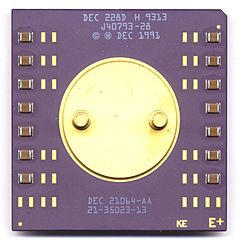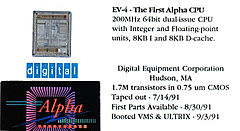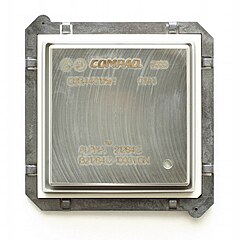
Back DEC Alpha BE-X-OLD DEC Alpha Czech Alpha-Prozessor German Alpha Esperanto DEC Alpha Spanish DEC Alpha Basque دک آلفا Persian DEC Alpha Finnish DEC Alpha French DEC Alpha Hungarian
 "Alpha Generation" logo used by Digital | |
| Designer | Digital Equipment Corporation |
|---|---|
| Bits | 64-bit |
| Introduced | 1992 |
| Design | RISC |
| Type | Load–store |
| Encoding | Fixed |
| Endianness | Bi |
| Extensions | Byte/Word Extension (BWX), Square-root and Floating-point Convert Extension (FIX), Count Extension (CIX), Motion Video Instructions (MVI) |
| Open | Yes[1] |
| Registers | |
| General-purpose | 31 plus always-zero R31 |
| Floating point | 31 plus always-0.0 F31 |
Alpha (original name Alpha AXP) is a 64-bit reduced instruction set computer (RISC) instruction set architecture (ISA) developed by Digital Equipment Corporation (DEC). Alpha was designed to replace 32-bit VAX complex instruction set computers (CISC) and to be a highly competitive RISC processor for Unix workstations and similar markets.
Alpha was implemented in a series of microprocessors originally developed and fabricated by DEC. These microprocessors were most prominently used in a variety of DEC workstations and servers, which eventually formed the basis for almost all of their mid-to-upper-scale lineup. Several third-party vendors also produced Alpha systems, including PC form factor motherboards.
Operating systems that support Alpha included OpenVMS (formerly named OpenVMS AXP), Tru64 UNIX (formerly named DEC OSF/1 AXP and Digital UNIX), Windows NT (discontinued after NT 4.0; and prerelease Windows 2000 RC2),[2] Linux (Debian, SUSE,[3] Gentoo and Red Hat), BSD UNIX (NetBSD, OpenBSD and FreeBSD up to 6.x), Plan 9 from Bell Labs, and the L4Ka::Pistachio kernel. A port of Ultrix to Alpha was carried out during the initial development of the Alpha architecture, but was never released as a product.[4]
The Alpha architecture was sold, along with most parts of DEC, to Compaq in 1998.[5] Compaq, already an Intel x86 customer, announced that they would phase out Alpha in favor of the forthcoming Hewlett-Packard/Intel Itanium architecture, and sold all Alpha intellectual property to Intel, in 2001,[6] effectively killing the product. Hewlett-Packard purchased Compaq in 2002, continuing development of the existing product line until 2004, and selling Alpha-based systems, largely to the existing customer base, until April 2007.[7]
- ^ Cite error: The named reference
facts and commentswas invoked but never defined (see the help page). - ^ Aaron Sakovich (2001). "Windows 2000?". The AlphaNT Source. Archived from the original on 2008-07-08. Retrieved 2007-01-01.
- ^ "SUSE Linux 7.0 Alpha Edition". SUSE. 2000. Archived from the original on 2014-01-08. Retrieved 2014-01-08.
- ^ George A. Darcy III; Ronald F. Brender; Stephen J. Morris; Michael V. Iles (1992). "Using Simulation to Develop and Port Software" (PDF). Digital Technical Journal. 4 (4): 181–192.
- ^ "Ghost of DEC Alpha is why Windows is rubbish at file compression". TheRegister.co.uk. November 2, 2016. Archived from the original on September 20, 2018. Retrieved September 20, 2018.
- ^ Popovich, Ken (2001-06-28). "Alpha proved costly for Compaq". ZDNet. Archived from the original on 2016-03-03. Retrieved 2016-03-02.
- ^ "Transforming your AlphaServer environment". HP. Archived from the original on 2007-02-08. Retrieved 2007-01-11.



